
As a person ages, the elasticity of the lens
a. decreases.
b. creases.
c. remains unchanged
d. improves.
Introduction:
The eye is a three-layered, fluid filled ball divided into two chambers. The sclera forms a white capsule around the eye, except at its anterior surface where it is specialized into clear cornea. The tough, fibrous sclera serves as the insertion point for external muscles that more the eyeballs within their sockets. A portion of the underlying choroid layer is darkly pigmented to absorb light rays at the back of the eyeball. In the front, the choroid layer is specialized into the iris (the structure that gives your eyes their color), the ciliary muscle, and the zonular fibers. Circular and radial smooth muscle fibers of the iris determine the diameter of the pupil, the anterior opening that allows light into the eye. The ciliary muscles determine the shape and focusing power of the crystalline lens just behind the iris. The retina is formed from an extension of the developing brain in fetal life on which the real and inverted image is formed. The eye is divided into two fluid-filled spaces- the aqueous humor between the iris and cornea and vitreous humor between lens and the retina.
Answer to Problem 1PL
Correct answer:
The correct answer is option (a) decreases.
Explanation of Solution
Explanation/justification for the correct answer:
Option (a) decreases. When the eye needs to focus on closely placed objects, the lens needs to change its shape and increase its curvature. This activity is mediated by the ciliary muscles. With the advancement of age, the lens become tough and it becomes difficult to change the shape of the lens. This means that elasticity of the lens decreases. So, the correct answer is option (a).
Explanation for incorrect answer:
Option (b) increases. As the lens becomes tough, it will naturally become less elastic. Therefore, elasticity decreases and does not increase. So, this is an incorrect option.
Option (c) remains unchanged. With the advancement of age, the ciliary muscles become weak and lens becomes tough. Therefore, slowly the condition of the eye starts to deteriorate. So, this is an incorrect answer.
Option (d) improves. As the lens becomes tough, it will naturally become less elastic. Therefore, elasticity decreases and does not improve. So, this is an incorrect option.
Want to see more full solutions like this?
Chapter 36 Solutions
Laboratory Manual For Human Anatomy & Physiology
- Can you described the image? Can you explain the question as well their answer and how to get to an answer to an problem like this?arrow_forwardglg 112 mid unit assignment Identifying melting processesarrow_forwardGive only the mode of inheritance consistent with all three pedigrees and only two reasons that support this, nothing more, (it shouldn't take too long)arrow_forward
- Oarrow_forwardDescribe the principle of homeostasis.arrow_forwardExplain how the hormones of the glands listed below travel around the body to target organs and tissues : Pituitary gland Hypothalamus Thyroid Parathyroid Adrenal Pineal Pancreas(islets of langerhans) Gonads (testes and ovaries) Placentaarrow_forward
- What are the functions of the hormones produced in the glands listed below: Pituitary gland Hypothalamus Thyroid Parathyroid Adrenal Pineal Pancreas(islets of langerhans) Gonads (testes and ovaries) Placentaarrow_forwardDescribe the hormones produced in the glands listed below: Pituitary gland Hypothalamus Thyroid Parathyroid Adrenal Pineal Pancreas(islets of langerhans) Gonads (testes and ovaries) Placentaarrow_forwardPlease help me calculate drug dosage from the following information: Patient weight: 35 pounds, so 15.9 kilograms (got this by dividing 35 pounds by 2.2 kilograms) Drug dose: 0.05mg/kg Drug concentration: 2mg/mLarrow_forward
- A 25-year-old woman presents to the emergency department with a 2-day history of fever, chills, severe headache, and confusion. She recently returned from a trip to sub-Saharan Africa, where she did not take malaria prophylaxis. On examination, she is febrile (39.8°C/103.6°F) and hypotensive. Laboratory studies reveal hemoglobin of 8.0 g/dL, platelet count of 50,000/μL, and evidence of hemoglobinuria. A peripheral blood smear shows ring forms and banana-shaped gametocytes. Which of the following Plasmodium species is most likely responsible for her severe symptoms? A. Plasmodium vivax B. Plasmodium ovale C. Plasmodium malariae D. Plasmodium falciparumarrow_forwardStandard Concentration (caffeine) mg/L Absorbance Reading 10 0.322 20 0.697 40 1.535 60 2.520 80 3.100arrow_forwardPlease draw in the missing answer, thank youarrow_forward
 Medical Terminology for Health Professions, Spira...Health & NutritionISBN:9781305634350Author:Ann Ehrlich, Carol L. Schroeder, Laura Ehrlich, Katrina A. SchroederPublisher:Cengage Learning
Medical Terminology for Health Professions, Spira...Health & NutritionISBN:9781305634350Author:Ann Ehrlich, Carol L. Schroeder, Laura Ehrlich, Katrina A. SchroederPublisher:Cengage Learning Comprehensive Medical Assisting: Administrative a...NursingISBN:9781305964792Author:Wilburta Q. Lindh, Carol D. Tamparo, Barbara M. Dahl, Julie Morris, Cindy CorreaPublisher:Cengage LearningEssentials of Pharmacology for Health ProfessionsNursingISBN:9781305441620Author:WOODROWPublisher:Cengage
Comprehensive Medical Assisting: Administrative a...NursingISBN:9781305964792Author:Wilburta Q. Lindh, Carol D. Tamparo, Barbara M. Dahl, Julie Morris, Cindy CorreaPublisher:Cengage LearningEssentials of Pharmacology for Health ProfessionsNursingISBN:9781305441620Author:WOODROWPublisher:Cengage





